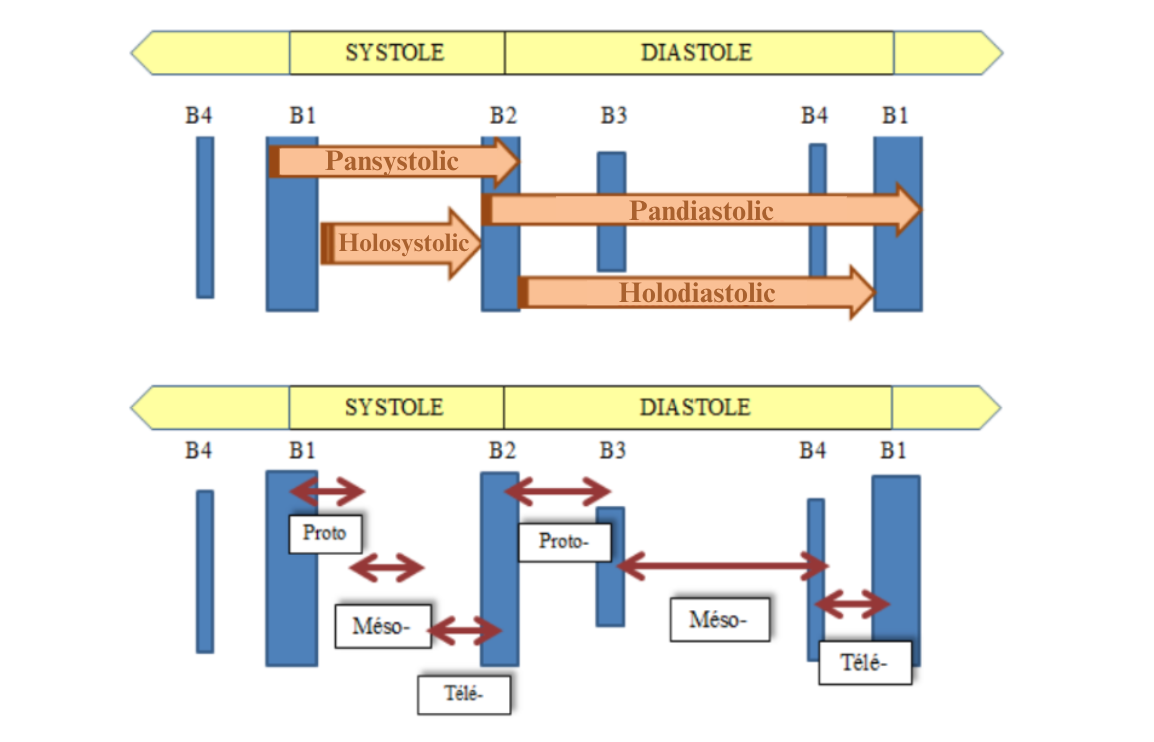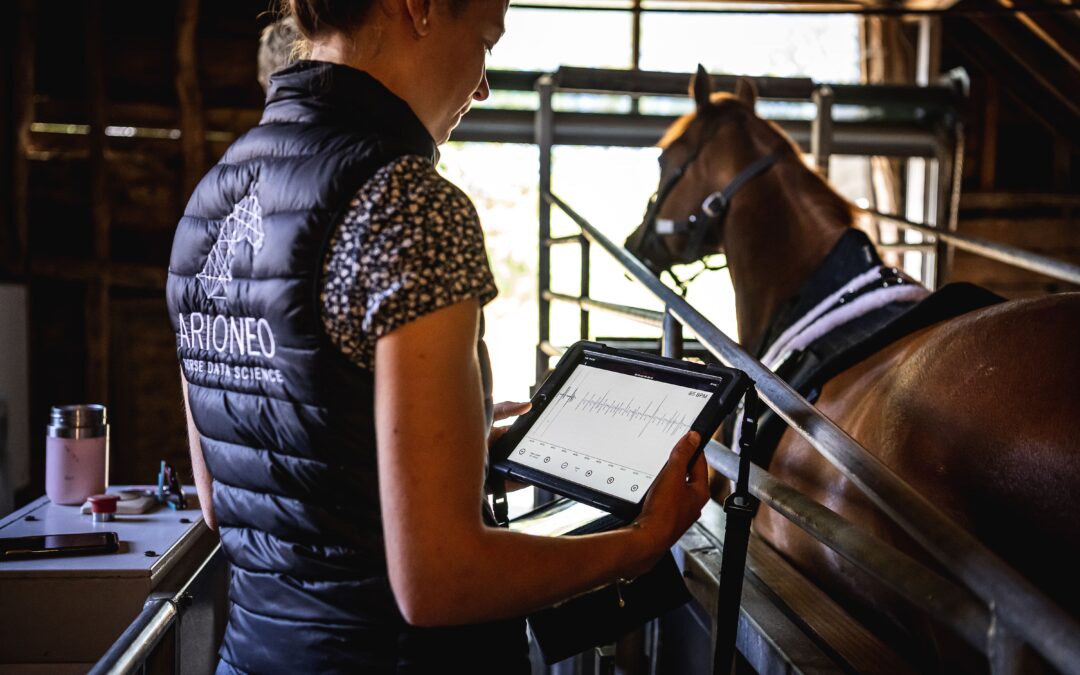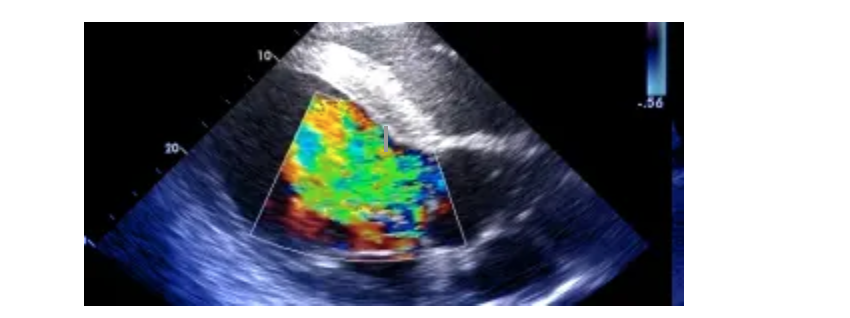The horse’s heart weighs 4 kg, is about the size of a basketball and is 25-30 cm long. The horse athlete produces intense efforts during training, and is able to considerably increase his cardiac capacity to adapt it to his practice, in order to send the necessary blood and oxygen to the muscles. The heart is the body’s blood crossroads, with arteries carrying oxygenated blood from the lungs to the organs and muscles, and veins carrying oxygen-depleted blood back to the body. This powerful muscle contracts during systole to propel the blood, and relaxes during diastole to refill with blood.
The cardiovascular system can be compared to a huge orchestra, and the presence of any structural defect can alter the functioning of the system and throw the orchestra out of harmony. A heart murmur is added to the initially audible heartbeat and becomes a false note in the orchestra, requiring the trainer to intervene on several levels.
How does a heart murmur affect a horse athlete? Where does it come from? Does it have an impact on performance?
Heart murmur characteristics

A heart murmur is an abnormal sound that can be heard superimposed on or added to normal heart sounds.
Initially, 2 beats can be heard, known as B1 and B2. They correspond respectively to the tensioning of the myocardium, the movement of intracavitary blood and the passive closure of the mitral and tricuspid valves, followed by the passive closure of the sigmoid valves (aortic and pulmonary). In the case of a horse with a heart murmur, either an ejection noise is added for a physiological murmur, or a noise due to leakage or regurgitation for a pathological murmur, known as B3. The abnormal sound is added to the initial heart sound, overlapping B1, B2 or both at the same time, in this case called a continuous murmur.
There are 3 main types of murmur:
- The physiological murmur is linked to an altered flow phenomenon altering cardiac output, i.e. the volume of blood expelled per unit of time.
- Functional murmurs are very common in racehorses. They have an advanced cardiovascular system to ensure good blood flow during intensive effort. Cardiac output and heart rate are considerably increased to meet the muscles’ consequent need for oxygen. The large diameter of the horse athlete’s blood vessels causes turbulent flow at the start of systole in the aorta and pulmonary arteries, resulting in a noticeable murmur.
- The pathological murmur is the consequence of a congenital malformation, i.e. a defect in the cardiac structure present at birth such as stenosis, or valvular cardiac lesions causing leakage.
The heart murmur is a complex anomaly for the veterinarian, who must accurately determine the horse’s capabilities. The veterinarian must give the owner-trainer short- and long-term indications of the horse’s heart health, and indicate the course of action to be taken in terms of long-term cardiac monitoring. The practitioner characterizes the abnormal noise heard and defines the state of progress and severity according to several parameters:
- The point of maximum intensity corresponds to the point where the blast has the greatest sound intensity. The grade is positioned on a scale from 1 to 6.
- Timbre corresponds to the set of frequencies that give it a certain sound and quality, describing the breath as dry, metallic, soft, rough, musical, clear, strident, muffled, etc.
- Radiation determines the extent of the area in which it can be heard simply by placing the stethoscope on it.
- Location on the heart (left/right, pulmonary, mitral, aortic and tricuspid projection zones)
- Time of appearance and chronology in an ECG cycle, i.e. whether systolic or diastolic.
- Type or quality:
– plateau: constant intensity throughout
– decrescendo: intensity peaks and gradually decreases
– crescendo: reverse
– crescendo-decrescendo: also called diamond-shaped

Possible causes
The appearance of a murmur, whether functional, physiological or pathological, indicates an abnormality in the functioning of the cardiovascular system. Determining the origin of this variation is crucial to adapting the horse athlete’s daily routine.
To find out more about the various cardiac pathologies in horse athletes, see our blog article: this article.
Pathological murmurs are audible both at rest and during exercise. It originates from a congenital disease or malformation characterized by a defect in the partitioning of the heart walls. It corresponds to a lack of airtightness, an interventricular communication causing the valve cavities to leak.
Physiological murmurs are highly prevalent in young horses and thoroughbreds. During exercise, it is linked to a very strong contraction of the heart, causing turbulence in the flow through the vessels and creating a vibration of the cardiovascular structures, but does not constitute a cardiac anomaly.
Heart murmurs can appear as a symptom in certain cases:
- Anemia is a lack of iron in the blood and a reduction in the number of red blood cells, which can cause a murmur by altering the viscosity of the blood,
- The same applies to hyperthermia,
- In the event of colic, the heart contracts more violently due to the pain, a condition known as inotropism.
- Valvulopathies – diseases of the heart valves – can cause turbulence in blood flow, and may include stenosis (narrowing) or leakage (regurgitation) of the valves,
- Abnormalities in the blood vessels near the heart can also cause heart murmurs, which may include congenital anomalies or acquired diseases. Some horses are born with cardiac anomalies known as congenital malformations, which can lead to pathological heart murmurs,
- Equine rheumatic fever, an inflammatory disease, can affect heart valves and also lead to heart murmurs.
How to detect it?
The symptoms
Beyond the difference in heart sounds perceived by the stethoscope, heart murmurs can manifest themselves through unusual changes that should alert the owner or trainer.
First of all, there are the unusual signs of exertion, particularly in athletic horses with highly developed sporting abilities:
- A horse athlete with abnormal noises may exhibit pronounced shortness of breath, prolonged recovery and profuse sweating, all of which are characteristic of the heart’s difficulty in ejecting blood into the body to meet muscular and metabolic needs.
- Intolerance to physical exercise is evidenced by rapid fatigue or difficulty maintaining pace during exertion.
- The counter-performance or drop in performance is generally of locomotor origin, followed by respiratory and then cardiac (in order of frequency). The veterinarian should be called in to carry out a full medical analysis.
- A relatively high heart rate is a sign that the horse’s heart and lungs are compensating for the loss of blood to the muscles by pumping more to meet the body’s demands during exercise.
To find out more about how to prevent counter-performance, we recommend this Webinar: this webinar.
At rest, you should also be alert to certain signs of abnormality:
- An accumulation of fluid in the lungs can cause a persistent cough, sometimes associated with a heart murmur.
- A drop in the horse’s general physical condition and weight loss, even without strenuous exercise.
- Fluid accumulation (edema) may occur in certain parts of the body, leading to abdominal or limb swelling.
- Anemia associated with a heart murmur can lead to paleness of mucous membranes, such as the gums.
- General weakness, including malaise and difficulty moving about.
- Some horses may become lethargic and less active due to poor blood circulation and reduced oxygen-carrying capacity.
Medical exams
To accurately identify the heart murmur profile, the veterinarian may perform several medical tests that will support his or her judgment and give a more accurate picture of the possible cardiac abnormality. As mentioned in the symptoms section, additional tests may be carried out following a poor performance or a purchase visit to a horse showing an abnormal sound when listened to with a stethoscope. To evaluate a heart murmur in a horse, the veterinarian may recommend a number of complementary tests and examinations.
These tests will help determine the underlying cause of the heart murmur and assess the severity of the condition. Here are some of the tests that can be performed:
- First medical consultation, the veterinarian looks at the horse in all static and moving aspects, including listening to the heart with a stethoscope to locate and get an initial idea of the location and intensity of the abnormal noise.
- An ECG records the heart’s electrical activity. It is generally carried out during exercise, to better detect any rhythmic abnormalities, reduced performance or heart failure, which are more likely to occur during training. The abnormality may take the form of an abnormal increase in heart rate during exercise and an excessively long recovery time, or a change in the ECG pattern (in the case of arrhythmia).

- Complete blood work-up, especially serology and blood cell count, to detect any anemia, infection or inflammation that may be the cause.
- Cardiac biomarker assay: some blood tests may include the measurement of specific biomarkers, such as troponins, which can indicate damage to the heart muscle.
- Ultrasound: a medical imaging technique that uses ultrasound to visualize the heart in real time. It can be used to assess valve structure, cardiac function and the size of the heart chambers, as well as to detect any abnormalities.
- Chest X-ray: can be performed to assess the size of the heart, detect any structural abnormalities and evaluate the presence of pulmonary edema.
- Doppler is a medical imaging technique using ultrasound to analyze blood flow conditions, which will be represented by colors on a screen. A heart structure colored blue and red is normal, while the appearance of green indicates regurgitation and abnormal blood flow, here associated with heart murmur.
The sporting impact on horse athlete
A heart murmur diagnosed in an athlete’s horse may or may not have an impact on sporting ability, depending on the size of the abnormality, the stage of development and the cause. Some are compatible with high-level competition.
The cardiovascular system can adapt to compensate for leakage by increasing respiratory capacity and cardiac output. Conversely, the system will decompensate if there is a possibility of long-term evolution and persistence of blood circulation disorders.
The appearance of effort intolerance, increased heart and respiratory rates, irregular rhythms and weakness show that the horse athlete is not in full possession of his or her cardiac capacities. According to a 1995 study by Reef et al., horses with a heart murmur grade 3 to 6, a resting heart rate in excess of 60 beats per minute, and those showing symptoms of congestive heart failure are statistically less likely to be successful. Physiological heart murmurs have not been shown to have any real impact on performance, and the same is true for horses with tricuspid regurgitation, which compensates in terms of vascular capacity, allowing the absence of influence on performance.
Systolic murmur
Systolic murmurs of the mitral valve lead to an increase in the size of the structure and functional indices of the left ventricle to compensate, so-called cardiac dilatation. However, the detection of moderate or severe aortic regurgitation in a young horse (under 10 years of age) shows an increased risk of reduced sporting performance and longevity.
Racehorses and young horses, particularly thoroughbreds, show a considerable prevalence. In the United Kingdom, Timeform (a British sports publication devoted to horse racing) has introduced the principle of annual classification based on several criteria, attesting to the horse’s numerical value in terms of performance. This qualitative index, expressed in pounds, is not negatively associated with heart murmurs or regurgitation, despite the high prevalence of this breed- and age-related anomaly.
In the case of a purchase, the diagnosis can be an obstacle during the veterinary visit. The practitioner needs to describe the murmur precisely in order to determine its possible evolution over time, so that the future buyer has all the keys in hand. The impact of a systolic heart murmur on an athlete’s sporting performance varies according to its origin. Mitral reflux has a major impact on performance. This anomaly develops more rapidly than others, due to significant pressure on the left ventricle. The stage of advancement is defined by the diameter of the left ventricle, using ultrasound. Symptoms include increased respiratory rate and amplitude on exertion, increased recovery time, possible coughing, exercise intolerance and sometimes atrial fibrillation. However, there may be no clinical impact on the horse, in which case it is characterized as a physiological ejection murmur.
Tricuspid reflux is more common in horses than mitral reflux, but its incidence is lower. Ultrasound usually shows a possible increase in atrial and right ventricular volume.
With normal exercise tolerance, and in the absence of excessive reflux or association with mitral reflux, the prognosis for life and sport is relatively positive.
Diastolic murmur
A diastolic heart murmur such as aortic reflux evolves and appears slowly, usually after 10 years, and is less common than the systolic murmur. On echocardiographic examination, a dilated left ventricular volume associated with thinning of the interventricular septum and free edge of the left ventricle, as well as dilatation of the aortic base, can be found. The vital and sporting prognosis depends on the speed at which the murmur develops, but it has no impact on the sporting performance of a racehorse. The slow onset of the murmur means that horses can tolerate the condition well, provided there are no signs of heart or lung failure.
According to a study published in the Journal of the American Veterinary Medical Association in 2000, no review of racing performance has revealed any association between sporting performance and this type of murmur. What’s more, the dynamic tests carried out in this study show that hairs without audible murmurs at low heart rates will not develop murmurs once heart rate is increased.
Conclusion
To date, there is no treatment for heart murmurs. Nevertheless, regular veterinary monitoring is recommended, particularly in the case of athletic horses subjected to intense repetitive effort, which places greater demands on their cardiac capacity.
Using EQUIMETRE to monitor a horse’s physical condition on a daily basis is a valuable tool for both trainer and owner. It provides a global view of a horse’s various performances, which can be used as a reference. The sensors record heart rate and transmit an ECG in real time to the data analysis platform, which can be closely monitored with the help of our data analysts at Arioneo. The heart rate is an indicator of the horse’s good health during exercise and during recovery, calculated 15 minutes later. The trainer can then easily see the positive or negative progression of the horse by comparing previous performances and training in terms of stride, locomotion and more. An abnormality may therefore manifest itself as a change in relation to reference values, and will require in-depth auscultation to find its cause.
The sensor created by Arioneo enhances training monitoring by providing precision and regularity. EQUIMETRE Vet allows you to act at the slightest sign of doubt, and to prevent possible pathologies or ailments. EQUIMETRE is constantly evolving to provide even greater precision, with data transmitted in real time. The platform communicates valuable data to the trainer, reflecting the horse’s response to exercise in terms of workload, locomotion and heart rate.
SOURCES:
- Christman, U. (2016, March). Dossier: cardiac affectations and their diagnoses in equines. Le Nouveau Practicien Vétérinaire, 11, 12.
- What is a heart murmur? – Clinique vétérinaire de Grosbois (n.d.). Clinique de Grosbois. Retrieved January 17, 2024
- What are the consequences of a heart murmur in horse athletes – Arioneo Webinar (2022, July 6). YouTube
- LATOUCHE, N. (1980, April 9). LA FIBRILLATION ATRIALE CHEZ LE CHEVAL [RETROSPECTIVE STUDY AND CLINICAL OBSERVATIONS]. In Thesis.
- CADON, A. (2011, December 19). PRACTICAL REALIZATION OF THE ECHOCARDIOGRAPHIC EXAMINATION IN THE HORSE AND PONY BASED ON BIBLIOGRAPHIC AND EXPERIMENTAL DATA. [Thèse].
- Heart murmurs in the horse: how to identifier them? What to do? – SNGTV. (n.d.). SNGTV.
- MASSENAVETTE, M. (2011, June 30). LEARNING THE DIAGNOSTIC APPROACH IN EQUINE CARDIOLOGY CONSULTATION FROM ILLUSTRATED CASES USING A COMPUTER TOOL [Thesis]
- Young, L. E., Rogers, K., & Wood, J. L. N. (2008). Heart murmurs and valvular regurgitation in thoroughbred racehorses: epidemiology and associations with athletic performance. Journal of veterinary internal medicine, 22(2), 418-426.
- Kriz, N. G., Hodgson, D. R., & Rose, R. J. (2000). Prevalence and clinical importance of heart murmurs in racehorses. Journal of the American Veterinary Medical Association, 216(9), 1441-1445.
- Reef, V. B., Bonagura, J., Buhl, R., McGurrin, M. K. J., Schwarzwald, C. C., van Loon, G., & Young, L. E. (2014). Recommendations for management of equine athletes with cardiovascular abnormalities. Journal of veterinary internal medicine, 28(3), 749-761.
- Vanel, M. (2010). The pathological dominants of the eventing horse (Doctoral dissertation).
- Variable, O. R. D. E. R. S. (2011). Heart Murmur. Clinical Veterinary Advisor: The Horse, 242.
- COTTIN, C. (2011). Prevalence of anorganic heart murmurs in a population of clinically healthy dogs.
- Evaluation of cardiovascular function in adult horses during systemic inflammatory response syndrome. (n.d.). DUMAS.
- Ultrasound in equine athletes. (n.d.). Cardio&Sport, 24.
- Equine medical imaging | Equine veterinarians Greater West. (n.d.). Equiwell.
- FERRAN, A. (2023). Physiology of heart sounds and ECG.
- Toutain, P.-L., LEFEBVRE, H., & DOSSIN, O. (1993). Physiological heart sounds in dogs and horses.
- Kriz, N. G., Hodgson, D. R., & Rose, R. J. (2000). Prevalence and clinical importance of heart murmurs in racehorses. Journal of the American Veterinary Medical Association, 216(9), 1441-1445.
Keywords : souffle cardiaque, performance, cheval, cardiovasculaire, ECG, flux sanguin, rythme cardiaque, repos, effort.



